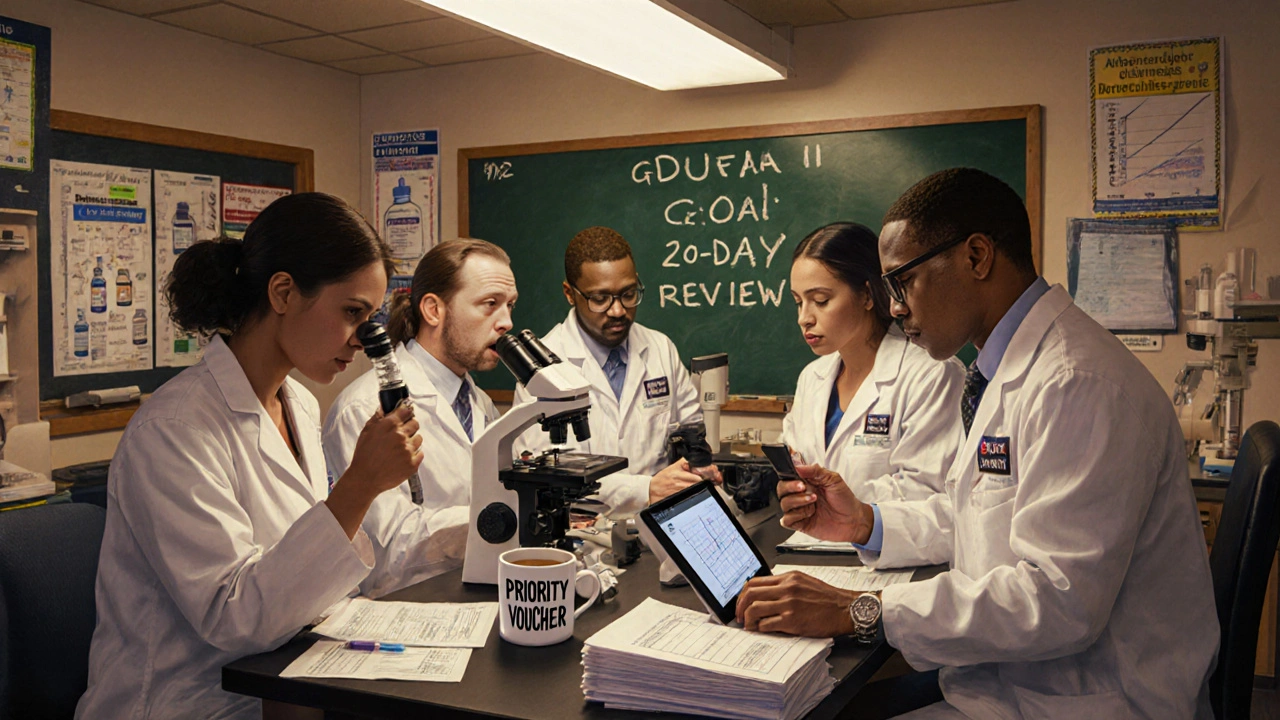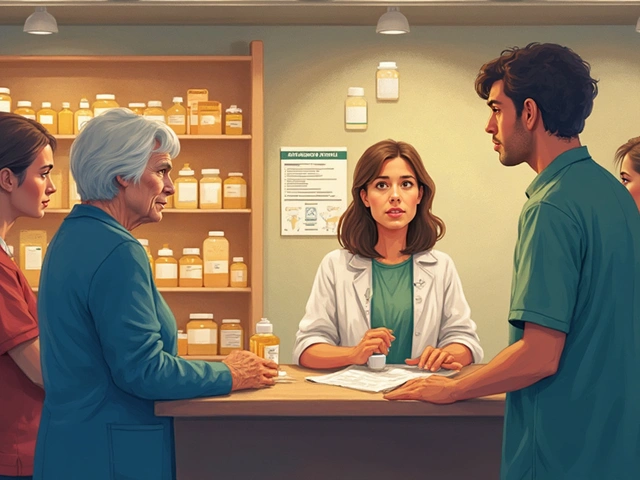When you pick up a generic pill at the pharmacy, it’s not just cheaper-it’s the result of a complex, tightly timed review process by the U.S. Food and Drug Administration. But how long does it actually take? If you’re a patient waiting for a life-saving medication to become affordable, or a manufacturer trying to bring a generic to market, understanding the FDA’s timeline isn’t just helpful-it’s critical.
Standard Review Time: Around 10 Months
The FDA’s standard review clock for a generic drug application, called an Abbreviated New Drug Application (ANDA), starts ticking once the agency accepts the submission as complete. That acceptance usually happens within 60 days of filing. After that, the official review period is 10 months. This isn’t a guess-it’s a legally binding target set by the Generic Drug User Fee Amendments (GDUFA).
That 10-month window is the baseline for most generic drugs. But here’s the catch: it’s not always that simple. Many applications don’t get approved on the first try. In fact, as of Q2 2025, over 42% of ANDAs receive a Complete Response Letter (CRL) during the first review cycle. That means the FDA found something missing-maybe a data gap in bioequivalence testing, an unclear manufacturing process, or an issue with labeling. When that happens, the clock stops until the applicant responds. Fixing those issues typically takes another 3 to 6 months per round.
What Drives the Variation? Complexity Matters
Not all generic drugs are created equal. A simple tablet like generic ibuprofen might get approved in under 8 months. But a complex nasal spray, injectable, or extended-release capsule? Those can take over a year-even two.
Why? Because proving bioequivalence for complex formulations is harder. The FDA needs more data. For example, a generic version of an inhaler must match the original not just in chemical composition, but in particle size, spray pattern, and lung deposition. That requires advanced testing and more scrutiny. In 2025, the FDA launched a dedicated team for complex generics, and since then, approval times for these products have dropped by 22%. Still, they’re far from fast.
Real-world examples show the range:
- Doxycycline Hyclate Oral Suspension - Approved in 9 months (standard formulation)
- Epinephrine Injection - Took 14 months due to stability and delivery system complexity
- Nasal Spray Generic - One manufacturer reported 1,087 days from submission to approval
That’s why manufacturers with experience-like Teva, Viatris, and Sandoz-often get approved faster. They’ve learned how to submit clean, complete applications the first time.
Priority Review: Faster, But Not Guaranteed
Some generics get priority status. This isn’t automatic. The FDA gives it to drugs that treat shortages, have no existing generic competition, or address unmet medical needs. For these, the review goal is 8 months instead of 10.
But here’s what most people don’t realize: even with priority status, delays still happen. A priority application with incomplete data will still get a CRL. And priority doesn’t mean “fast-tracked to approval”-it means “fast-tracked to review.” The quality bar doesn’t drop.
There’s also a new tool in play: the Commissioner’s National Priority Voucher (CNPV) program. Announced in late 2025, this lets the FDA fast-track certain applications down to just 1-2 months. But it’s not open to everyone. Only a handful of applications per year qualify-usually for drugs that treat rare conditions or are in critical shortage. Think insulin, epinephrine, or antiviral generics during a public health emergency.

What’s Changing in 2025? AI, Rolling Review, and New Goals
The FDA isn’t standing still. In 2025, the agency rolled out AI tools to help reviewers analyze data faster. Early results show a 15.8% reduction in review time for standard generics using AI-assisted analysis. That might not sound like much, but when you’re reviewing thousands of applications a year, it adds up.
Another change: rolling review. Instead of waiting to submit a full ANDA, companies can now send in parts as they’re ready-chemistry data first, then manufacturing, then clinical. This cuts down the time spent waiting for the entire package to be ready.
And the goals are getting bolder. Under GDUFA III (2023-2027), the FDA aims to approve 90% of standard ANDAs by their goal date. For priority reviews, the target is 75%. By 2027, they’re shooting for a median approval time of just 20 days for standard generics and 10 days for priority ones. That’s ambitious. And controversial.
The Trade-Off: Speed vs. Safety
Not everyone is cheering the faster timelines. Dr. Peter Lurie from the Center for Science in the Public Interest warned in August 2025 that rushing approvals without rigorous checks could risk patient safety. He’s not alone. Some manufacturers report inconsistent feedback from reviewers-what one team accepts, another rejects.
The FDA says it uses a risk-based approach: higher-risk products get more scrutiny. But the data shows that first-cycle approval rates are improving. In 2024, only 37.8% of ANDAs passed on the first try. In 2025, that number jumped to 42.3%. That suggests the system is getting better-not just faster.
And the results speak for themselves. Generic drugs now make up 90% of all prescriptions in the U.S. but cost only 23% of total drug spending. Over the past decade, they’ve saved the healthcare system $1.7 trillion. Faster approvals mean more savings-and more access.

What Manufacturers Need to Do to Speed Things Up
If you’re a company trying to get a generic approved, here’s what works:
- Submit a complete application. Missing chemistry or manufacturing data is the #1 reason for delays. Use the FDA’s pre-submission meeting to get feedback before you file.
- Use the right format. Follow the FDA’s electronic submission guidelines. Paper applications are still accepted, but they’re slower.
- Don’t wait for perfection. If you’re working on a complex product, use rolling review. Submit what you have, when you have it.
- Target priority status. If your drug treats a shortage or has no competitors, apply for priority review. It’s worth the extra paperwork.
Small companies can also apply for fee waivers. In 2025, only 4.7% of ANDA applicants qualified-but those who did saved over $138,400 in user fees.
Who’s Winning? The Top Generic Manufacturers
Market share tells a story. Teva leads with 18.3% of approved generics, followed by Viatris (14.2%) and Sandoz (11.7%). These companies don’t just have big budgets-they have deep relationships with the FDA. They attend pre-submission meetings, use AI tools, and submit clean applications. Their average approval time is 15-20% faster than smaller firms.
It’s not just about money. It’s about experience. The more you know how the FDA thinks, the less likely you are to get a CRL.
What’s Next? The Road to 2027
The FDA’s long-term plan is clear: faster, smarter, safer. By 2027, they want to cut median approval times to 20 days for standard generics. That’s a huge leap. But it depends on funding. The Congressional Budget Office warns that without more money, progress could stall after 2027.
For now, the trend is positive. Generic approvals are outpacing novel drug approvals in 2025. More patients are getting affordable meds. More manufacturers are succeeding on the first try. And AI is quietly becoming a game-changer.
But the bottom line hasn’t changed: the FDA’s job isn’t to rush drugs to market. It’s to make sure they’re safe, effective, and truly equivalent. Speed matters-but not at the cost of quality.
How long does the FDA take to approve a generic drug?
The FDA’s standard review time for a generic drug (ANDA) is 10 months after the application is accepted. For priority applications-those addressing shortages or with no existing generic-the goal is 8 months. Complex products can take longer, sometimes over a year. First-time approvals and those using AI-assisted review may be faster.
Why do some generic drugs take longer to approve than others?
Complex formulations-like injectables, nasal sprays, or extended-release tablets-require more testing to prove they work the same as the brand-name drug. The FDA needs more data on how the drug behaves in the body, how it’s made, and how stable it is. Simple tablets are easier to copy, so they move faster.
What is a Complete Response Letter (CRL)?
A Complete Response Letter is the FDA’s way of saying your application isn’t approved yet. It lists what’s missing or needs fixing-like unclear manufacturing details, incomplete bioequivalence data, or labeling issues. Responding to a CRL usually adds 3-6 months to the timeline. About 42% of ANDAs get a CRL in the first review cycle.
Can the FDA approve a generic drug in less than 10 months?
Yes. The FDA has started using AI to speed up reviews, cutting standard review times by 15.8% in pilot programs. Also, the new Commissioner’s National Priority Voucher program can approve certain high-need generics in just 1-2 months. Rolling review lets companies submit parts of their application early, which can shorten overall time.
Are faster generic approvals safe?
The FDA says yes. They use a risk-based approach, focusing more scrutiny on high-risk products. First-cycle approval rates are improving, meaning fewer applications need multiple rounds of review. While some experts warn about potential quality risks, data shows that safety standards haven’t dropped. The goal is to be faster without cutting corners.
How do I know if my generic drug is approved?
The FDA publishes all approved generic drugs on its website in the Orange Book. You can search by drug name, manufacturer, or active ingredient. Once approved, the drug can be legally marketed. If you’re a patient, your pharmacist will know if a generic is available and approved for your prescription.






Comments
Kelsey Worth
27/Nov/2025sooo... the fda takes 10 months to approve a pill but my amazon package takes 2 days? 🤔 guess i’ll just wait for the generic version of my anxiety meds... or maybe i’ll just buy it off instagram. #fda2025 #genericwhyyyy
Nirmal Jaysval
27/Nov/2025in india we get generics in 3 months and no one dies. why usa so slow? fda like old man with magnifying glass checking every letter on pill bottle. also teva? they got 18% market share? lol they got 18% of my money too. #indianpharma
Emily Rose
27/Nov/2025Look, I get the frustration, but let’s not pretend this is just bureaucracy for the sake of bureaucracy. The FDA isn’t slowing things down because they hate you-they’re trying to stop another Vioxx situation. I’ve worked in pharma compliance, and I’ve seen what happens when corners are cut. One batch of bad generic metformin can kill dozens. The fact that first-cycle approval rates are UP means the system is learning, not failing. If you want faster, help manufacturers submit cleaner applications-not yell at regulators. We can do better without sacrificing safety. Seriously, let’s stop villainizing the people trying to keep us alive.
Benedict Dy
27/Nov/2025The claim that AI reduced review times by 15.8% is statistically insignificant given the sample size and lack of peer-reviewed validation. Furthermore, the FDA’s own data shows that 42% of ANDAs receive a CRL-this is not an efficiency gain, it’s a symptom of poor applicant preparation. The agency’s goal of 20-day approvals by 2027 is a fantasy without increased funding, staffing, and stricter pre-submission standards. This isn’t innovation-it’s political theater dressed up as progress.
Emily Nesbit
27/Nov/2025Actually, the FDA doesn't 'accept' applications within 60 days-it's a 60-day filing window, not an acceptance guarantee. And '10 months' is the goal, not the median. The median is closer to 14. The article conflates targets with reality. Also, '1,087 days' for a nasal spray? That’s not a delay-it’s a failure of the applicant to understand formulation science. The FDA is doing its job. The problem is the industry’s lack of rigor.
John Power
27/Nov/2025Hey, I just want to say-this is actually really helpful. I’ve got a cousin on insulin, and I didn’t realize how much time and effort goes into making generics affordable. It’s easy to get mad when you’re waiting, but reading this made me appreciate how hard the FDA works to balance speed and safety. Thanks for breaking it down without jargon. 🙏
Richard Elias
27/Nov/2025so teva gets approved faster? no surprise. they’ve got lawyers sleeping in the fda lobby. and that ‘rolling review’ thing? just a fancy way of letting big pharma cut in line. small companies? good luck. the system’s rigged. and don’t even get me started on those ‘priority vouchers’-who’s deciding what’s ‘critical’? probably the same people who own the brand-name drugs.
Scott McKenzie
27/Nov/2025Big thanks for this breakdown 🙌 I’m a med student and this is exactly the kind of real-world insight we don’t get in textbooks. The AI angle is wild-imagine reviewers using tools like ChatGPT to parse bioequivalence data. Also, the 90% approval rate goal? That’s the kind of ambition we need. Keep pushing for transparency, FDA. We’re rooting for you 💪
Jeremy Mattocks
27/Nov/2025Let me tell you, as someone who’s sat through three rounds of CRLs for a complex extended-release capsule, this article is both accurate and painfully understated. The FDA reviewers aren’t the enemy-they’re overworked, underpaid, and often stuck with outdated software. I spent six months fixing a labeling issue because one paragraph didn’t match the exact font size they wanted. Six months. For a font. Meanwhile, the same team approved a new cancer drug in record time because it had priority status. The system isn’t broken-it’s just unevenly resourced. And yes, rolling review helped us cut 11 months off our timeline. But only because we had a team of 12 people working 14-hour days. The real bottleneck isn’t the FDA-it’s the industry’s inability to plan ahead. We need more training, more funding, and less of this ‘blame the regulator’ nonsense. We’re all trying to get life-saving drugs to people. Let’s stop fighting each other and fix the pipeline.
Paul Baker
27/Nov/2025the fda is just slow because they dont want generic drugs to be too cheap 😂 also why do they even exist if they take a year to approve a pill? just let people buy them and if someone dies then sue the company later 🤷♂️ #freegeneric #pharmaisaracket